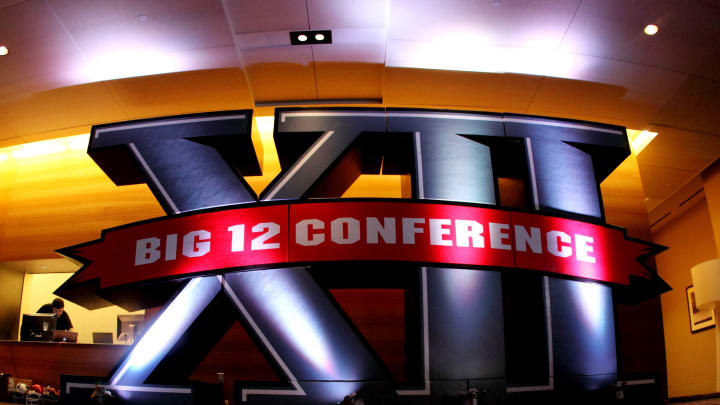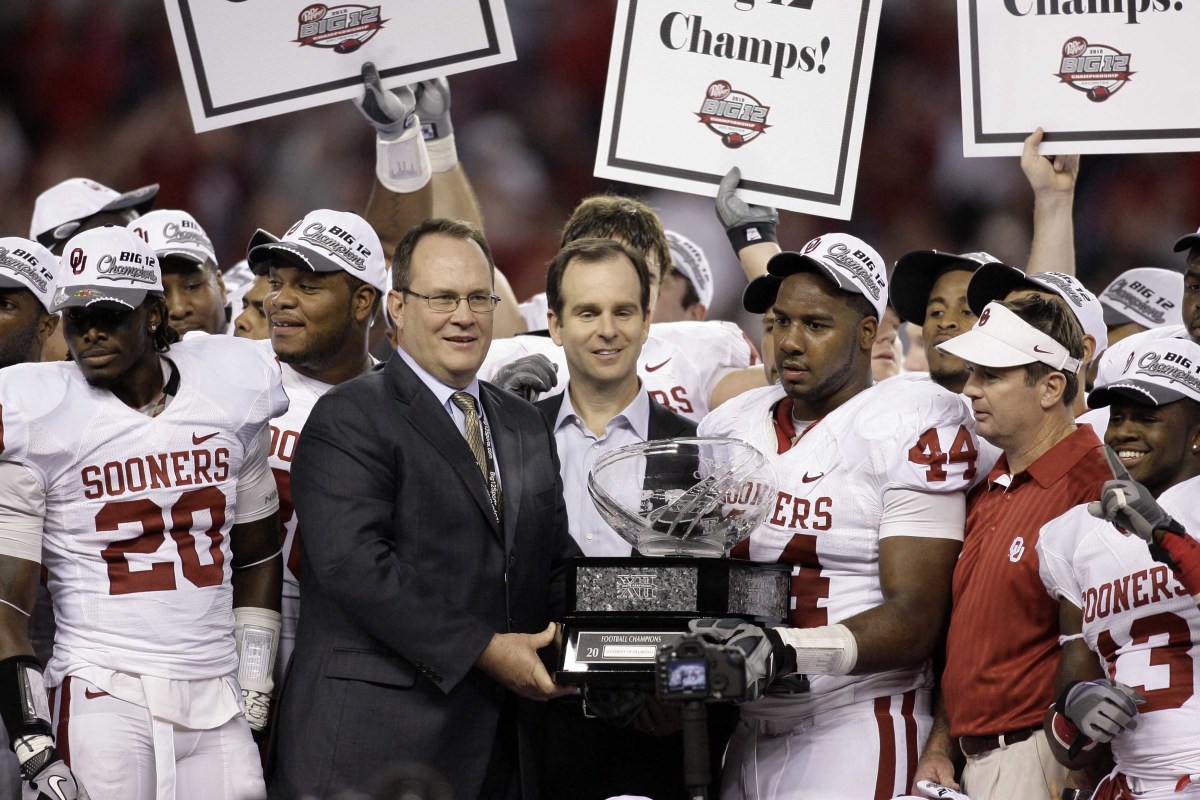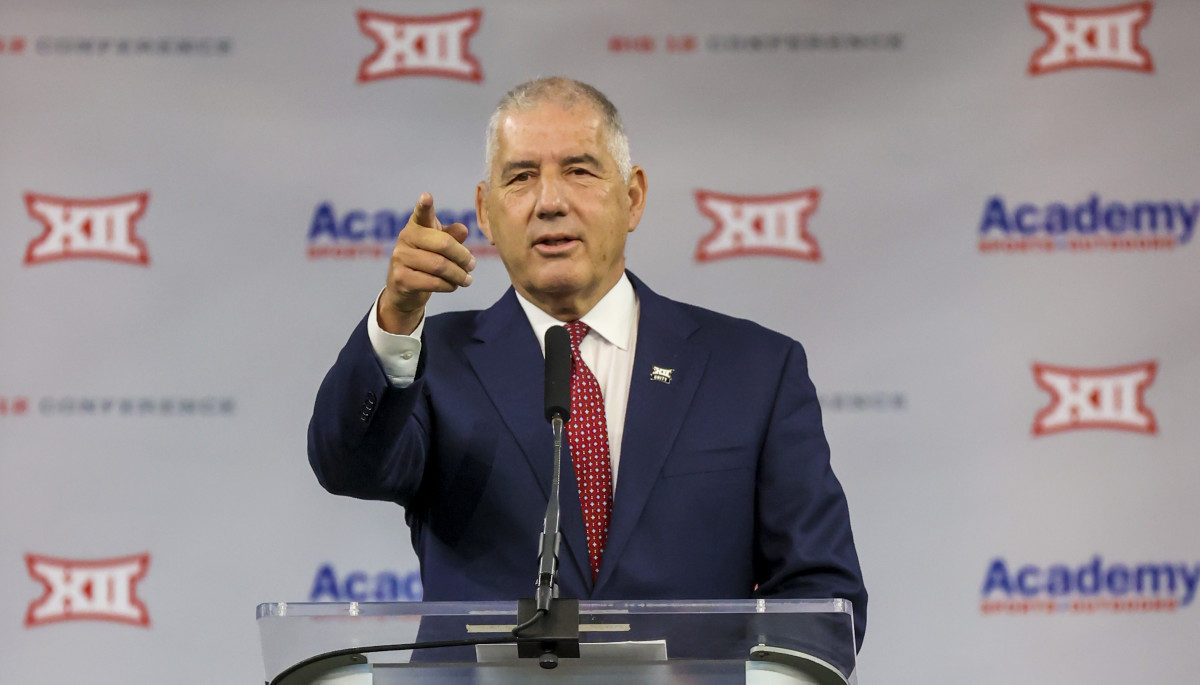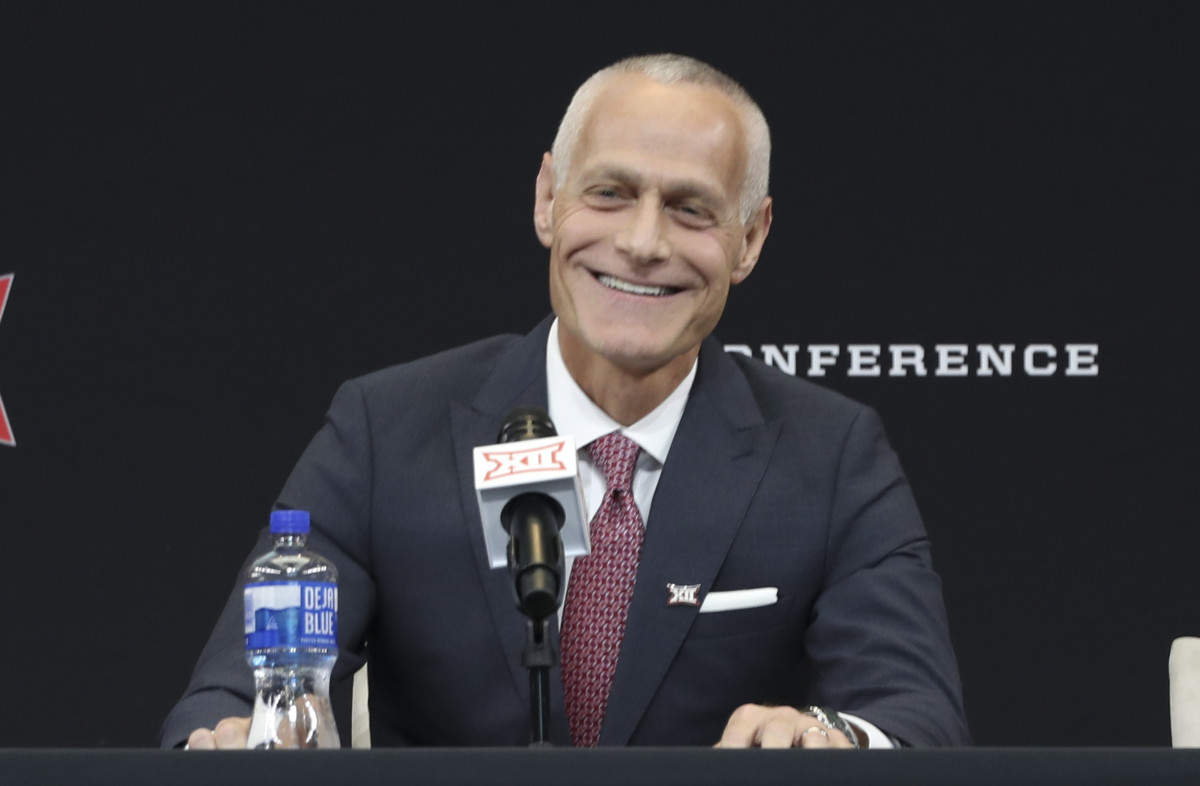COLUMN: The Unlikely Story of How the New Big 12 Finally Got Here, and What's Next

At the stroke of midnight, college athletics looked a little different.
As the calendar turned to July, the new Big 12 Conference became officially official, and — for one year, at least — has four new family members in the league.
BYU, UCF, Cincinnati and Houston formally became Big 12 members at midnight on Saturday, July 1. It begins an awkward 365 days for a league that was built out of desperation, has lived off discord, fought off distrust, often stumbled between reaction and inaction, and has twice teetered on oblivion.
Make no mistake, the Big 12 is resilient. The Big 12 is a survivor.
Officially official. pic.twitter.com/JYB1L4lSYU
— Big 12 Conference (@Big12Conference) July 1, 2023
But exactly one year from now, the flagships at Oklahoma and Texas will leave this ragtag fugitive fleet for calmer and more lucrative seas in the Southeastern Conference, jumbling Big 12 membership from 10 to 14 to 12 in the span of 12 months — and despite today’s cheery additions, forcing the league to stare once more into the abyss.
The Big 12 has had its moments of greatness, to be sure. In the early days, with Nebraska coming off a decade of dominance and Texas still elite and Missouri and Colorado and Texas A&M consistently competitive in football and Oklahoma State trending up and Mike Leach synonymous with Texas Tech and Bill Snyder’s Miracle in Manhattan — and, eventually, Bob Stoops and Oklahoma lording over it all — Big 12 football was once feared and respected nationwide.
Those perceptions changed in the late 2000s and early 2010s as the league evolved into a quarterback-centric conference where defense was optional.
History speaks. Greatness awaits. pic.twitter.com/KE6zno2gBK
— BYU Cougars (@BYUCougars) July 1, 2023
At the same time the Big 12 was trending toward one brand of football, the SEC was heading in the other direction. The SEC quickly went from a fun collection of traditional powers to an unbeatable behemoth, a unified army of football mercenaries that scooped up 5-star prospects and turned them into first-round draft picks, an orthodox football league that still cherished bone-jarring defense over trapeze-artist offense.
Still, even though the SEC and the Big Ten separated on the football field, the Big 12 eventually became arguably the nation’s best basketball conference. That’s something.

But it’s football that pays the bills, football that changes NCAA rules, football that gets NIL laws passed and football that emboldens schools to switch conferences over a simple philosophical disagreement or a few million dollars a year. So Big 12 football suffered — on the field, sure, but especially so in the board room.
While David Boren called the Big 12 “psychologically disadvantaged” and DeLoss Dodds shrugged off Tom Osborne’s frequent complaints of inequity and Missouri began seriously looking at membership elsewhere and Colorado jumped as Texas legislators squabbled over the political and religious leanings of Baylor and Texas A&M summoned all its hate for the Longhorns and decided enough was enough — while all that was unfolding, the SEC was digging a trench and building a fort and putting together an unprecedented run of seven straight national championships in football.
The best is yet to come.
— Cincinnati Bearcats (@GoBEARCATS) July 1, 2023
Welcome to Day One.#Bearcats | @Big12Conference pic.twitter.com/vovAca1Ph4
It’s a run that has been interrupted, but largely continues today — and shows no signs of abating. Just ask Nick Saban and Kirby Smart.
Meanwhile, in the grain belt, one commissioner after another couldn’t soothe the discontent between the Big 12’s presidents and chancellors. So Kevin Weiberg left and fortified the Big Ten with his idea of a conference-wide television network. Dan Beebe, once a feared NCAA investigator, was run out of town on a realignment rail, unable to herd the Big 12’s fat cat CEOs. Along came Bob Bowlsby, a respected voice of reason in college athletics from Iowa via Stanford and a stint with the Olympics, and what chance did he ever have in a league so divided?

Even renowned college football fixer Chuck Neinas, commissioner of the old Big Eight in the 1970s and successful broker of many a TV negotiation, couldn’t wield a hammer big enough to permanently fix the Big 12’s dysfunction when he returned as interim commissioner in 2011-12.
In 2010, Oklahoma, Texas and a few other Big 12 members had all but signed their contracts to join the Pac-12. The Big 12 was falling apart, and unequal revenue sharing and the Longhorn Network and favoritism toward all things Lone Star State for the northern schools were at the heart of the matter. But suddenly Colorado left for the Pac-12, Nebraska bolted for the Big Ten, and panic set in.
Big City. Big Moments. Big 12. pic.twitter.com/pEKkij065t
— Houston Athletics (@UHCougars) July 1, 2023
Beebe didn’t quite survive to see the revenue sharing get leveled out, but Neinas did a few days after Beebe was fired.
Cooler heads prevailed, the whole Big 12 didn’t follow the Buffs, and a new set of problems came to the forefront, most visibly A&M’s dislike of Texas and its ESPN vehicle, LHN, and the SEC’s growing interest in Missouri.
Neinas met those challenges head on despite A&M and Missouri leaving in 2011 (Missouri left 10 days after Neinas had declared they were staying). But he was never intended to be a permanent fixture in the Big 12’s Las Colinas offices. He said in 2011 he had a “strong affection” for the Big 12 and was a key figure “in the background” in the conjoining of the Big Eight and remaining Southwest Conference that originally formed the Big 12, but never wanted to stick around to preside over the conference or its many problems.
Time to Launch @Big12Conference 🚀 pic.twitter.com/fUyEVxTnja
— UCF Knights (@UCFKnights) July 1, 2023
Still, it was impressive to watch Neinas in such a short time crank the gears that would eventually add TCU and West Virginia to the Big 12 roster and bound everyone with an unbreakable 12-year grant of media rights and keep the league from dissolving forever — whether they liked it or not.
Soon after Neinas’ one-year redux, Big 12 leadership turned things over to Bowlsby — a sensible choice at the time, but one that felt overwhelmed from the beginning.
Bowlsby then presided over the league’s embarrassing 2016 attempt at expansion, during which Big 12 leaders “interviewed” expansion candidates — Cincinnati, Houston, UCF, BYU among them — through video conferencing (before video conferencing was cool — or, really, a necessary evil) and then unceremoniously decided not to expand. It was another missed opportunity.

The truth is, the Big 12 was always doomed — not to outright failure, but to decades of infighting and an ever-shifting membership and middling status among its peers.
After the SEC added Arkansas and South Carolina in 1992, big-time college athletics changed forever, and especially so in the Big Eight and SWC. Missouri and Kansas began flirting with the Big Ten. Texas began flirting with the Pac-10 and then the SEC. Texas A&M had been flirting with the SEC for years.
So when the Big Eight and SWC merged into the Big 12, it felt tenuous at best, a stop-gap effort despite the best efforts of Neinas and Weiberg and others.

There were a few, of course, like OU-Texas, Kansas-Missouri and Texas A&M-Texas, but the Big 12 lacked the proliferation of deep-seated, traditional-hate rivalries that fuel leagues like the SEC and Big Ten.
Now, under visionary new commissioner Brett Yormark — a self-described basketball junkie who’s embracing football a little more every day — the Big 12 will tout rivalries like Houston and Baylor, WVU and Cincinnati, UCF and … BYU?
At the pace college sports is evolving today, how long can a three-time-zone conference — half of whose members are either brand new or just a decade invested — remain solvent, or even relevant?
Give Yormark credit. He’s doing his best to expand the Big 12 brand into New York City and Mexico City and cities unknown. Maybe Gonzaga will join someday as a basketball-only member. Maybe after UCLA and USC formally join the Big Ten next July, Yormark can poach Arizona and Arizona State, or Utah and — how’s this for irony? — Colorado from the Pac-12.

In any case, Yormark showed savvy Friday afternoon when he put out a statement — welcoming not the Big 12’s new member institutions, but the Big 12’s new (same old) media partners.
“The Big 12 Conference is thrilled to announce it has executed its long-form agreements for the extension of its media rights with partners ESPN and Fox through the 2030-31 academic year,” Yormark said.
A statement from the Commissioner. pic.twitter.com/l2qxHEVdU2
— Big 12 Conference (@Big12Conference) June 30, 2023
“We would like to thank both ESPN and Fox for their continued partnership. … This deal not only provides stability for the Big 12 in years to come, but it creates a strong foundation for future growth and innovation.”
It marked another important if unlikely victory for the Big 12, jumping ahead of the Pac-12 on the media rights negotiations calendar and landing a couple of high-profile, traditional linear TV partners while the Pac-12 continues to twist in the wind without any agreement forthcoming. In less than a year on the job, Yormark has worked wonders doing what his predecessors couldn't: convincing Big 12 execs to do thing his way and let him be the leader they hired.
When OU and Texas in the summer of 2021 announced their intention to leave, Bowlsby told the Texas legislature that the league would lose 50 percent of its media revenue. Bowlsby later walked that figure back, and although clearly that summer was yet another harbinger of doom for a league that has nearly died several times, the Big 12's new TV deal illustrates just how far off he was.
The contract begins in 2025 and was reported last October as six years and $2.28 billion.
The existing eight members will see a very nice (media-only) revenue kick, expected to rise from $220 million a year to $380 million (or from $22 million to $31.7 million), putting the total revenue near the $50 million mark per school.
Once again, reports of the Big 12's demise have been greatly exaggerated.
The four newcomers will enjoy life-changing new money, all the games will be televised by ESPN or Fox, and the Big 12 will continue along like it always has, great people in a fun conference, always entertaining, moderately successful despite the odds, and surviving occasionally in spite of itself.
- Want to join the discussion? Click here to become a member of the AllSooners message board community today!
- Sign up for your premium membership to AllSooners.com today, and get access to the entire Fan Nation premium network!
- Follow AllSooners on Twitter to stay up to date on all the latest OU news!
- Want even more Sooners news? Check out the SI.com OU team page here!
- Listen and subscribe to the AllSooners Podcast!
- Watch more Sooners videos and subscribe on YouTube!
